The stages of installing separate gas equipment - a hob and an oven - are similar to installing a conventional gas stove, but they also have their own characteristics. Sometimes users only connect the gas hob, since they do not use an oven or prefer an electric model.
If you decide to carry out the installation work yourself or want to control the work of specialists, we propose to analyze in more detail how to connect the gas hob with your own hands.
The content of the article:
-
Steps for connecting a gas hob
- Stage 1 - preparation of equipment and tools
- Stage 2 - cutting a hole in the countertop
- Stage 3 - connecting the panel to electricity
- Stage 4 - connecting the panel to the gas main
- Stage 5 - leak check and testing
- The nuances of connecting to a gas cylinder
- Conclusions and useful video on the topic
Steps for connecting a gas hob
The process of installing the equipment takes no more than an hour, most of the time is spent on preparatory work and calling the wizard to get an opinion.
There are four stages:
Image gallery
Photo from
The use of an electric oven or the electric ignition function requires an electrical connection. It is necessary to install a separate socket connected to the circuit breaker on the panel
The connection is made taking into account the manufacturer's recommendations. If you need to connect two devices, then you will need two flexible connections - separately for the panel and the oven. The insert is carried out by employees of the gas service
To install the panel, a hole is cut out on the countertop. To simplify installation work, you can order a tabletop with a hole for the specified dimensions. If you plan to install an oven, then you need to prepare the cabinet.
It is not recommended to test for leaks and put gas equipment into operation on your own. There is a procedure for calling a specialist, which cannot be violated. Based on the results of the check, a permit for use is issued
Connecting equipment to electricity
Panel connection to gas
Installation in a furniture set
Diagnostics and testing
There are many preparatory activities behind each stage: the purchase of gas equipment and related materials, coordination of the time of calling a specialist, preparation of kitchen modules for insert of devices. Let's analyze each stage separately to prevent possible errors.
Stage 1 - preparation of equipment and tools
We recommend purchasing the hob in advance. If this is not possible, then you need to find out the exact dimensions. Usually all 4-burner models correspond to the standard 50 * 60 cm (+/- 2 cm), 3- and 2-burner models, respectively, are smaller in width.
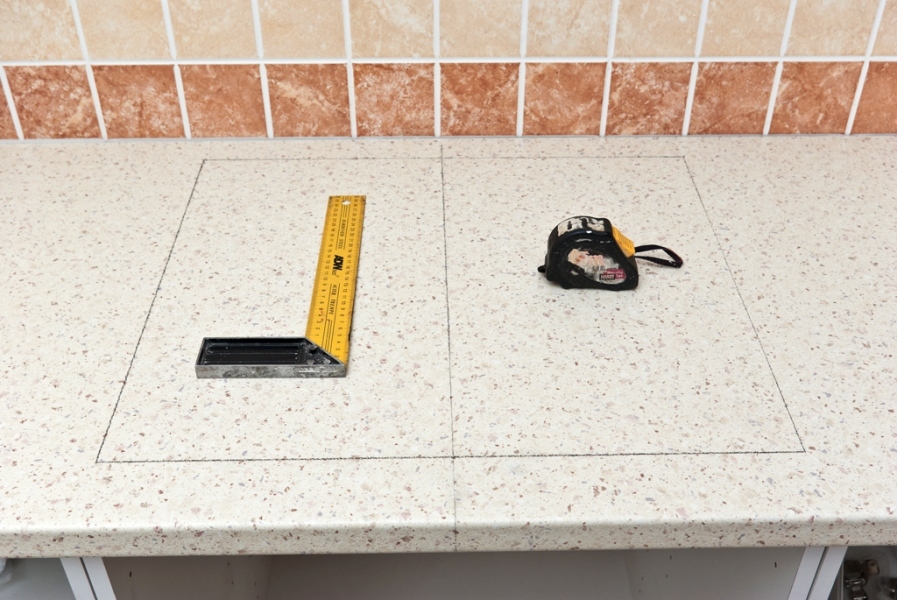
For installation, a kitchen cabinet with a working width of at least 60 cm is required, so that at least 5 cm of countertops remain at the edges of the panel for stability and strength
In addition to gas equipment, you will need to buy the following materials:
- dielectric insert;
- flexible gas hose (1 or 2);
- linen thread.
Fasteners for mounting are usually included in the kit, so you do not need to buy them.
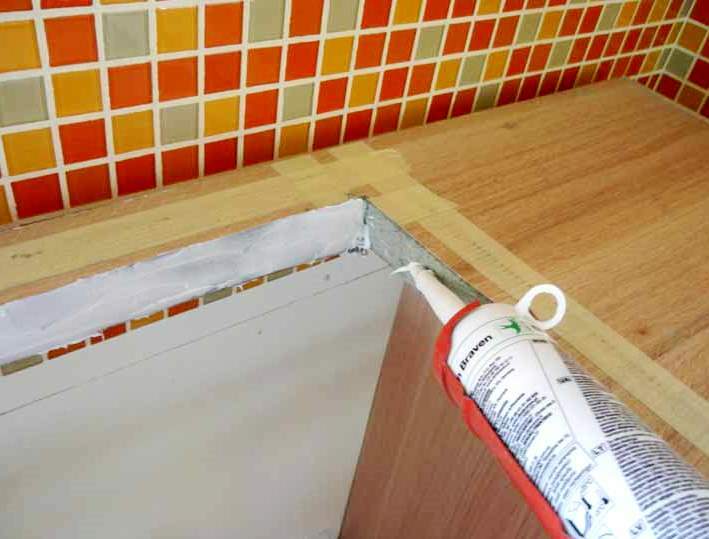
If you decide to firmly fix the hob on the worktop, then a sealant will also come in handy - a universal composition for any type of material: stone, wood, metal
Of the tools, you will need a standard set, which every home craftsman usually has: a pair of gas keys, a screwdriver, pliers. If it is necessary to cut a metal pipe, then this is the concern of the representatives of the service organization - it is impossible to independently perform any actions with the gas supply pipes.
Stage 2 - cutting a hole in the countertop
Knowing the exact dimensions of the hob, you can make a hole in the worktop in advance. Of course, the factory would have handled this more professionally, because it is very important to cut a neat rectangle with right angles and even sides.
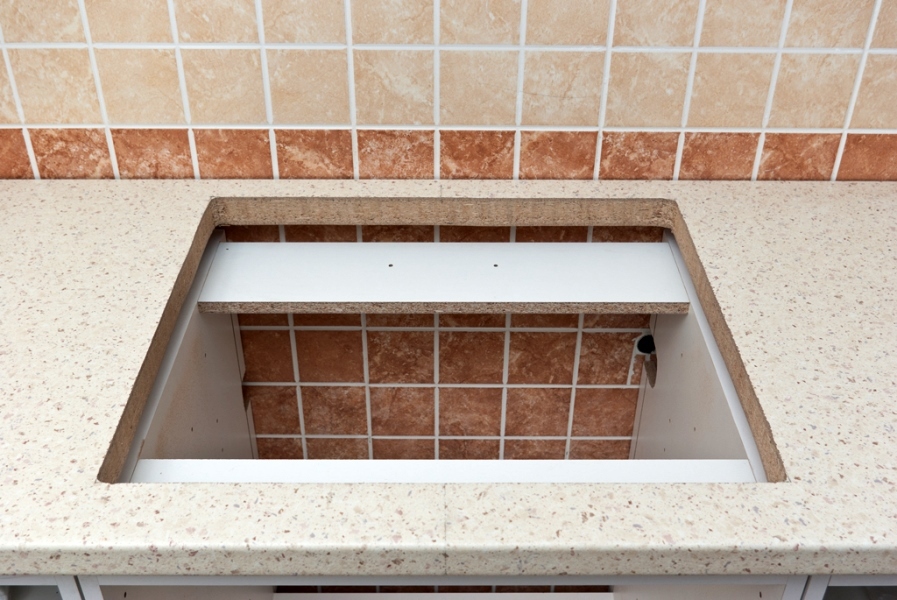
If you adjust the length and width of the hole "to size" and perfectly align the edges, the panel will stand firmly and without the use of sealant
The help of furniture makers will come in handy when the tabletop is made not of chipboard, MDF or wood, but of a more durable material - artificial stone.
If you decide to make a hole yourself, then use a lightweight and productive tool - for example, a jigsaw.
Procedure:
- Check again the dimensions of the panel, study the installation diagram.
- Mark the countertop with the recommended distance from the wall.
- Glue paper tape around the perimeter, draw the outline of the fragment to be removed with a pencil or marker.
- Use a jigsaw to cut a hole. First, it is recommended to make a short cut, then - at the wall, and last - side ones.
- Remove the cut out piece of the countertop.
- If the panel is at hand, immediately make a "fitting".
If the material of the table top crumbles at the cut, you can process the edges with any adhesive, but first you need to sand and vacuum. For chipboard, sanitary silicone is used - it additionally protects the edges from moisture.
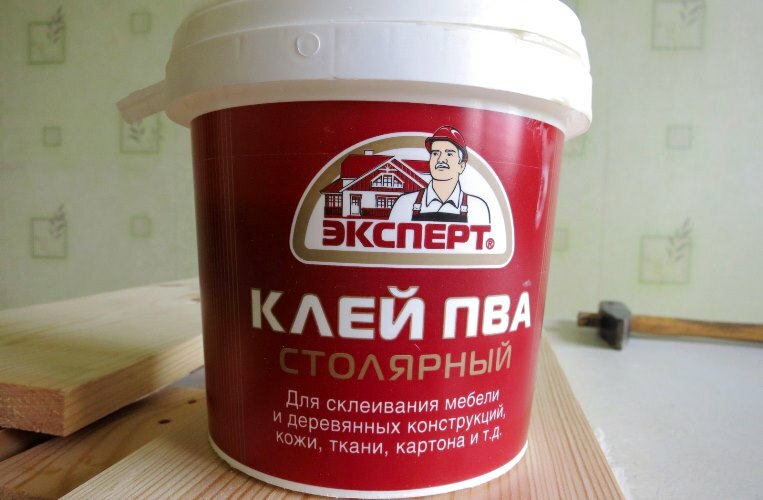
Silicone sealant forms a film that eventually separates from chipboard, so many people use moisture-resistant (3D index) PVA glue
You can also use thermal foil or an aluminum tape reflector to prevent the counter top from being exposed to high temperatures.
Stage 3 - connecting the panel to electricity
Modern hobs are equipped with an electric ignition function, therefore, a power outlet will need to be installed.
An electric oven is often installed along with the gas hob. To connect a device with a power of up to 3.5 kW, you will need:
- three-core cable vvg-p 2.5 mm;
- 16 A socket with grounding;
- if the kit does not include a connecting wire, then a 3 * 2.5 mm pvc cable and a plug.
For a more powerful oven, you will need a 3.5 mm cable and a 40 A socket.
According to the norms, the installation height of the outlet is no higher than 90 cm, while it should not be on the same level with the hob.
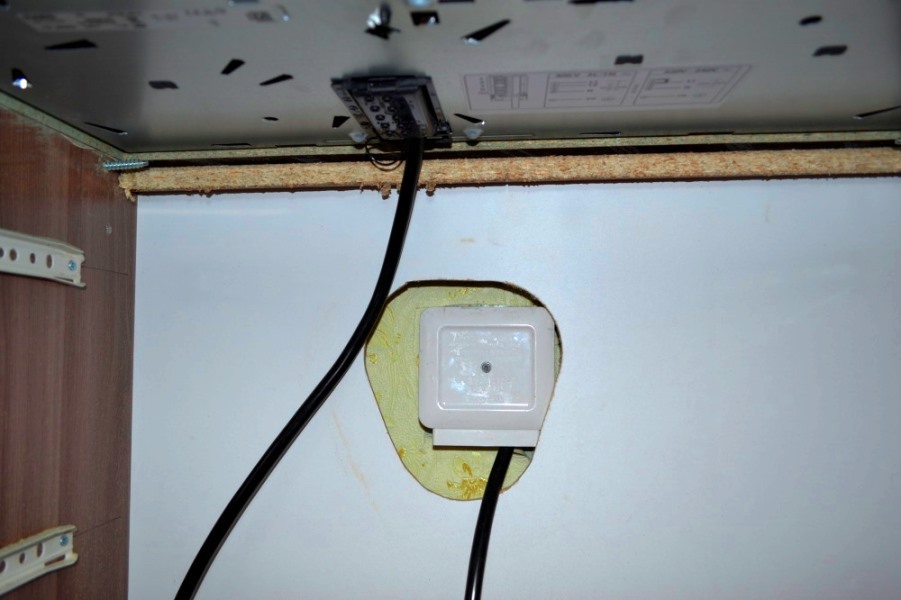
The socket is installed on the wall under the countertop, and if the cabinet has a "blank" wall, then you will need to cut a hole for free access
For protection, a separate RCD or difavtomat is installed in the switchboard - separately on the line of gas cooking equipment.
The socket is installed in a standard way: first, the junction box is fixed in the wall, then the terminals are connected, and the decorative panel is fixed on top. You can read more about the installation of sockets for electric stoves in this material.
Safety regulations:
- the manufacturer recommends using the services of a professional electrician;
- on the underside of the device there is a plate with the technical characteristics required for the mains, from which it is impossible to deviate;
- the electric cable must not be twisted, pinched, laid near sharp corners;
- after installation work, all conductive elements must be insulated and protected against accidental contact.
Subsequent repairs should only be carried out with the device disconnected from the mains.
Stage 4 - connecting the panel to the gas main
To properly connect the hob to gas, you need a flexible adapter - a hose no more than 2 m long. Often, due to the inconvenient layout, longer hoses are also used, but this is prohibited by the rules for the operation of gas equipment.
On sale you can find various gas connections with fabric, rubber and metal braiding. Bellows hoses are becoming more and more popular, which are characterized by wear resistance and a longer service life.
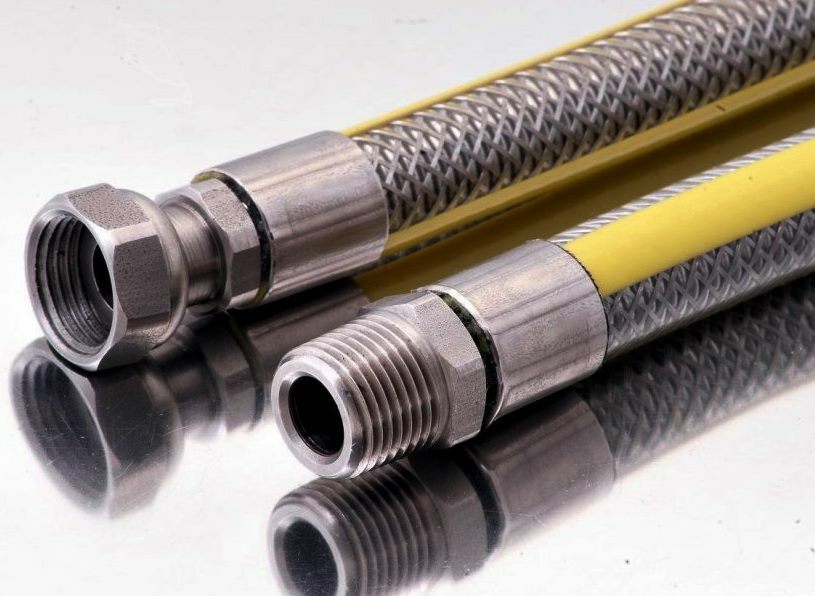
Gas hoses can be identified by yellow markings on connectors or along their entire length. Distinctive features of eyeliner - strength, flexibility, resistance to deformation
In addition to the hose, a dielectric insert is required. It is installed on the pipe in front of the shut-off valve.
The dielectric serves as a safety feature - it protects both equipment and users from stray currents.

Dielectric couplings with external or internal threads are popular with installers. They differ in thread diameter, thread / nut design, external design
Suppose that the clutch is already installed, then we proceed in the following order:
- We connect the gas hose to the dielectric. If not, then to the metal pipe immediately after the tap. For the tightness of the abutment, we use flax or fum tape.
- On the underside of the panel we find a small threaded pipe and wind the hose in the same way.
You do not need to perform any more actions.
If you want to simultaneously connect the gas hob and the oven, then you should use two connections. But keep in mind that connection through a tee is not welcomed by all representatives of Gorgaz! For example, MosGaz employees write out a prescription and insist on laying a gas pipe.
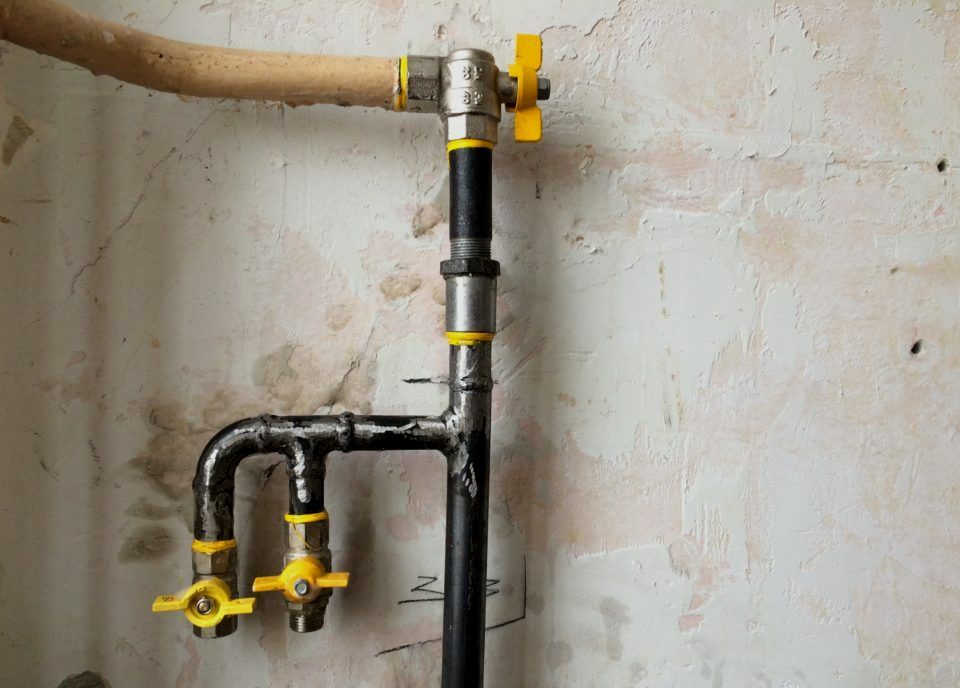
For wiring, welding will be required, which can only be performed by employees of the service organization. Payment for the procedure is at the expense of the homeowner
This connection method is considered more correct for two reasons:
- the number of threaded connections is reduced, thereby increasing the tightness and safety;
- shut-off valves are installed on both branches - in the case of using a tee, one common valve is retained.
We remind you that all actions, if you decide to connect on your own, need to be coordinated with the employees Gorgaz or Oblgaz - and then there will be no unpredictable situations ending in expensive repairs.
Stage 5 - leak check and testing
You can check the tightness of the threaded connections on your own. To do this, arm yourself with a brush and cover them with soapy water.
But the final conclusions will be made by the checking employee - he will also check the eyeliner for leaks, and then will draw up a conclusion, which will indicate the date of visit, brands and serial numbers of gas equipment, type eyeliner.
It is not recommended to start operation before the arrival of a gas service employee; in case of an accidental leak, all responsibility falls on the shoulders of the homeowner. But the main thing is the safety of family and friends, so there is no need to rush and take risks.
The nuances of connecting to a gas cylinder
If in cities and large villages, residential buildings and apartments are connected to natural gas, then in villages and summer cottages they often use LPG cylinders. This is due to the fact that no gas pipeline has been laid near the settlements.
Connection stages cooking gas hob to the cylinder the same as for a normal pipe connection. The difference is that when using cylinders, the devices are being modified so that the combustion process occurs more efficiently.
When the cylinder is connected, an increased pressure is observed, due to which there is a lack of oxygen. The result is a yellow flame unusual for gas burning and a large amount of soot. The problem can be solved by replacing nozzles designed for natural gas - methane, with analogues for LPG.
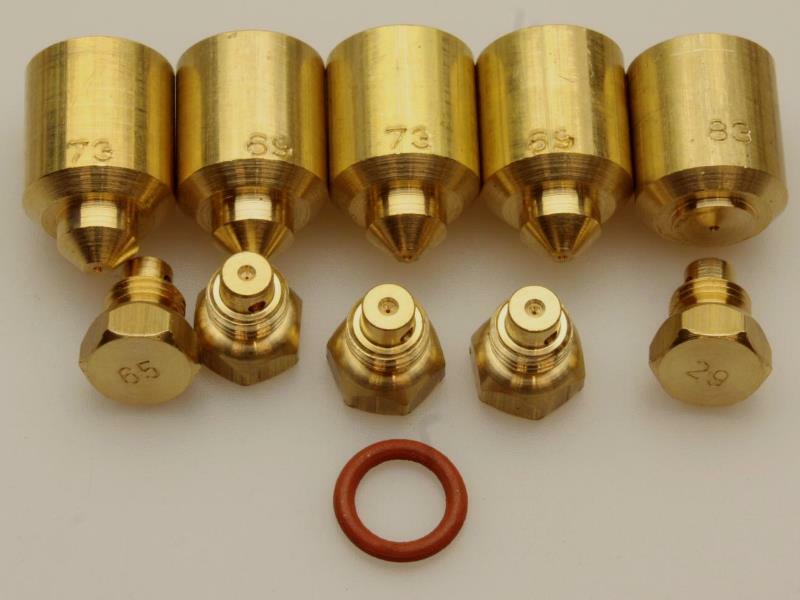
Often, a set of LPG jets is included with a new hob. If they are not available, then you must purchase separately in a specialized store.
The process of replacing the nozzles is simple, instructions can be found in the installation manual of the appliance.
All work on the completion of the equipment is carried out with the cylinder disconnected - it is connected last.
What else do you need to remember when connecting the hob of the hob to LPG?
Image gallery
Photo from
Due to safety requirements, it is forbidden to place cylinders in residential premises and behind fragile partitions. Usually they are installed outdoors, in a sturdy casing, at a minimum distance from the gas appliance.
Propane reducers are used to normalize combustion when pressure changes. A distinctive feature of gas reducers is red or metallic. They are matched to the characteristics of the panel and configured manually
For connection, use flexible bellows or rubber hoses if there is no possibility of connecting with a metal pipe. A case is made for a passage in the wall - a metal pipe is inserted and coated with cement
A tap is installed in front of the connection point of the gas pipeline to the hob. Its purpose is to cut off the gas supply if equipment maintenance or repair is required. Gas taps are marked in yellow
Place of installation of gas cylinders
Gas reducer for connection
Hose for connecting the cylinder to the hob
Fuel shut-off valve
When using several cylinders, use connecting ramp, which reduces the volatility of the fuel and reduces the risk of freezing in the gearbox.
After installing all the elements, it is necessary to check the operation of the hob. First, it is tested for leaks using a soapy solution. Then the valve on the cylinder is unscrewed and the adjustment is made reducer. If the flame is yellow or there is a lot of soot, it is necessary to reduce the pressure by slightly tightening the valve.
And finally, an employee of the Oblgaz should be invited to confirm and register the fact of connecting the new equipment. In the future, the service will be carried out by the relevant organization.
Conclusions and useful video on the topic
Preparation of the worktop and the nuances of installing the hob:
Video instructions and helpful tips:
Rules for connecting to a gas pipe:
Whatever actions you do with gas equipment, they must meet the installation requirements and safety rules.
Before starting work, we recommend that you study the provisions of SNiP 42-01-2002, and then - the manufacturer's instructions. Any deviations from the norms remove the equipment from the guarantee and threaten with trouble with the gas workers, the smallest of which is a fine.
Please tell our readers about your experience of connecting or replacing a gas hob. Leave your comments, upload photos, ask questions - the contact block is located under the article.


